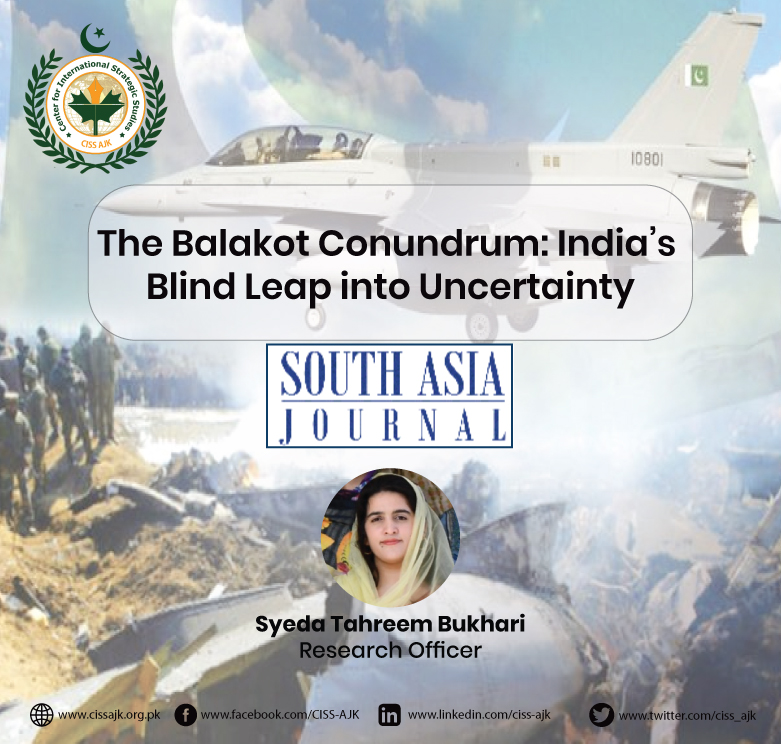617
On February 14, 2019, forty personnel of Central Reserve Force Police killed in Pulwama by a vehicle-borne suicide bomber. The attack was claimed by Jaish-e-Muhammad, a banned terrorist outfit from Pakistan. In response to the attack, on February 26, 2019 at 3:30 am India launched airstrike in Balakot, Pakistan violating the territorial sovereignty of the state.
One of Chinese general Sun Tzu’s dictums could better explain the Balakot Strike:
If you know the enemy and know yourself, you need not fear the result of a hundred battles. If you know yourself but not the enemy, for every victory gained, you’ll also suffer defeat. If you know neither the enemy nor yourself, you will succumb in every battle.
The Balakot Strike proves that India knew neither the enemy nor itself. The Balakot incident brought up significant doubts about India’s ground and air forces’ capacity for warfare. Since the 1971 war, this was the first time that Pakistan and India had engaged in a dogfight, and there were concerns that the Indian Air Force was ill-prepared for the mission in Balakot. Additionally, allegations surfaced indicating that the IAF’s Mirage 2000 aircraft lacked the capability to deliver payload on the target. Furthermore, IAF targeted its own Mi-17 helicopter after being perplexed by Pakistan’s counterattack. It brought to light the incapacity of Indian forces to handle pressure in times of crisis and the absence of a well-coordinated defence.
The Balakot incident also called into question the accuracy of India’s intelligence, as the incident validated India’s claim to have successfully hit terrorist outfits in Pakistan territory and inflicted significant causalities, there was limited independent verification of the damage caused. Pakistan disputed India’s claims, as no such training camps of terrorists existed there, stating that the airstrikes caused minimal damage and resulted in no casualties. Furthermore, international observers and media outlets raised doubts about the evidence provided by India to support its claims.
The revelations regarding Pulwama Attack which was used as pre-text to intervene in Pakistan’s territory, not only vindicate Pakistan but also expose the fact that how India could use terror incidents in its own country for larger internal or external objectives. The Pulwama terror attack was caused by systemic failure, including egregious security and intelligence lapses, according to former Jammu and Kashmir Governor Satya Pal Malik, who also claimed that the tragedy was used for political purposes. Malik further claimed that Prime Minister Narendra Modi had told him to keep quiet after he exposed the security lapses that preceded the attack. The Central Reserve Force Police who were sacrificed becomes a focal point during elections, yet there’s a noticeable absence of keeping the promises made towards them afterward. The family of the martyrs recognized the fact that the Pulwama incident was for political mileage as no one remembered martyrs after polls are over.
The Balakot Strike created a “fog of war,” between Pakistan and India with a nuclear threat looming threatening the strategic stability of South Asia. Pakistan’s Operation Swift Retort, that too in daylight in response to the Indian Air Force’s strike has undermined India’s conventional deterrence strategy based on air power. The Pakistan Airforce strikes were intended to uphold the credibility of its air power and prevent the shrinking of space for conventional warfare. The tension was de-escalated by Pakistan after returning Indian fighter pilot in gesture of peace.
In the weeks following the Balakot Strike, analysts within the Indian Air Force have observed the condition of India’s “vintage” jets and the lack of hardened shelters near the Line of Control to protect Indian aircraft. The IAF has lost sixteen aircraft in the last fiscal year, eight of which occurred in the last two months, including a MiG-21 that was shot down by a Pakistani F-16.
The Balakot strike serves as a stark reminder that Pakistan gains air superiority over India. The significance lies not in whether the Pakistan Air Force (PAF) executed a superficial breach of the Line of Control during the strikes on February 27. What holds importance is its utilization of air power, notably in broad daylight. The seemingly reciprocal and proportionate response by Pakistan played a pivotal role in preserving the realm for conventional warfare.



